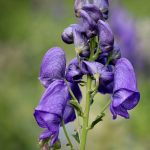 Striking bright blue flowers borne on spikes. Recognized as a poison since antiquity, it was used to poison arrows. Contains aconitine, a useful sedative for many conditions. Not to be used without medical supervision.
Striking bright blue flowers borne on spikes. Recognized as a poison since antiquity, it was used to poison arrows. Contains aconitine, a useful sedative for many conditions. Not to be used without medical supervision.
The dried roots of the herbaceous plant Aconitum napellus (monkshood of wolfbane), containing three analgesic substances: aconine, aconitine, and picraconitine . Aconite was formerly used to preparation for toothache, but is regarded as too toxic for use today.
The dried tuberous root of Aconitum, especially A. napellus (monkshood) and A. lycoctonum (wolfsbane); a poisonous alkaloid that may cause life-threatening cardiac arrhythmias. Aconite is believed to have been used as an arrow poison early in Chinese history and perhaps also by the inhabitants of ancient Gaul. It was also used as an herbal remedy in traditional Chinese medicine.
